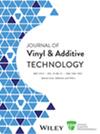Bio-based and effective: Cardanol-piperidine derivatives for enhanced polypropylene resistance against thermo- and photo-oxidative aging
Abstract
Bio-based antioxidants have garnered attention for their sustainability and environmental benefits. In this study, we designed and synthesized three cardanol-piperidine derivatives (HSs) by utilizing hydrogenated cardanol (HC) and piperidine derivatives to improve the aging inhibition of polypropylene (PP). These bio-based antioxidants were intended as eco-friendly alternatives to conventional synthetic antioxidants. The impact of these HSs on the thermal stability, thermo-oxidative stability, and light stability of PP was thoroughly evaluated. The results unveiled that after 5 h of interaction with 2,2-diphenyl-1-picrylhydrazyl free radical, HSs exhibited a remarkable over 5-fold increase in free radical scavenging efficiency as compared to HC. Moreover, the addition of HSs significantly increased the oxidation induction time and the initial oxidation temperature compared to pristine PP. After photo-oxidative aging and thermo-oxidative aging, the HS-dosed PP demonstrated remarkable retention of elongation at break, reaching more than 72% and 69%. From the comparison with physical mixtures and the density functional theory calculations, an intramolecular synergism mechanism is proposed. The intramolecular synergism between hydrogenated cardanol and piperidine derivatives may be the main reason for the inhibition of PP aging.
Highlights
- A method for constructing simultaneous efficient light, thermal, and oxygen stable polypropylene.
- The mechanism for achieving simultaneous stabilization of light, heat, and oxygen is the intramolecular synergy of phenol piperidine.
- The essence of intramolecular synergy of cardanol and piperidine derivatives is its' reduced hydrogen bond dissociation energy and energy gap.

 求助内容:
求助内容: 应助结果提醒方式:
应助结果提醒方式:


